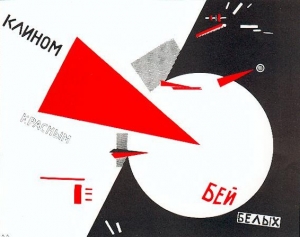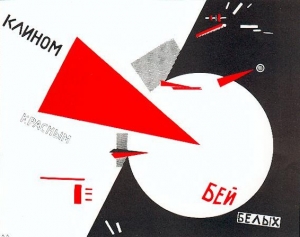
Books Please! The Russian Revolution, Arts and Culture
Mike Quille outlines some of the ways the Russian Revolution has influenced art and culture across the world in the last 100 years.
The Bolshevik Revolution in October 1917 was the world’s first attempt to create a socialist society. It was based on the active support of the majority of the population, workers and peasants alike, and apart from ending Russia’s disastrous involvement in the First World War, it liberated and enfranchised the Russian population politically, socially and economically. It was radically progressive in its social policies – for example towards women and children – and in particular in its truly comprehensive education policies, as outlined in an article by Megan Behrent in this new, commemorative section of Culture Matters.
What about its impact on culture? Unquestionably, the Revolution gave a massive boost to creativity and imagination and led to an explicit recognition, by artists and Bolsheviks alike, that art could serve the general population rather than elites, and thus advance the aims of the Revolution. The natural links between artistic creativity and emancipatory politics were made – not for the first time in human history, but in the strongest way to date.
This explosion of creativity occurred in the visual arts, film, poetry, ballet, children’s literature, music and many more popular cultural pursuits including sport and science, theatre and theology, fashion and clothing. Hardly an area of human cultural activity was unaffected by the Revolution - for an illuminating discussion of its effect on science, see Andy Byford's Revolution and Science under the Bolsheviks.

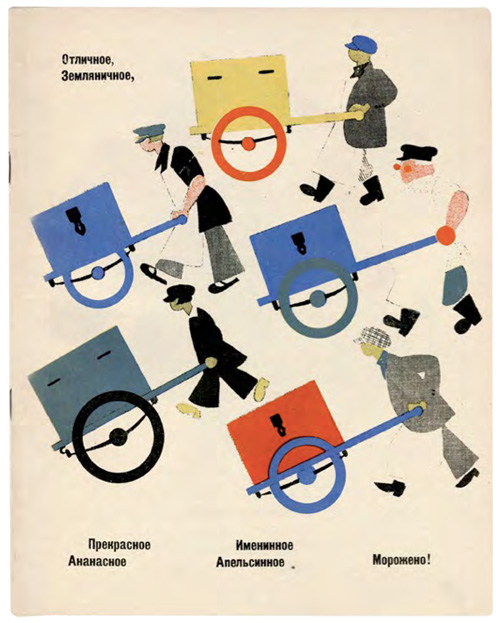
Children's literature from the 1920s
Complementing the energy and political focus of cultural workers like artists and poets - see John Ellison's article on Alexander Blok - came a qualitative and quantitative change in the reception and appreciation of culture. There was a massive improvement in the ability and willingness of the mass of working people to engage with and enjoy the arts and other cultural activities, thanks to the government’s progressive educational policies and bold, imaginative attempts to connect the masses to culture, for example in the agit-trains and agit-boats that carried the political art of Mayakovsky, Lissitzky and Malevich to hundreds of thousands of workers and peasants.


Agit-train; Agit-boat with theatre on board
These kind of bold, ambitious initiatives, developed in a relatively poor and backward country a century ago, make a telling contrast with our Arts Council’s timid attempts to encourage 'community engagement'. State policy towards the arts in this country is still dominated by the elitist mission of subsidising the interests of the richer segments of metropolitan populations.
What is often less discussed is the cultural impact of the Revolution across the world outside of Russia. It was a massive influence at the time, and has been for the last hundred years. Indeed, the purposes, meanings and effects of the Revolution on culture are still being played out today - a kind of 'cosmic background radiation', as Andrew Murray vividly describes it.
This brief survey will sketch out those influences, with a few examples where space allows. They are grouped into three kinds of influence.
The revolutionary impact on cultural workers
Firstly, there was the direct and worldwide influence of the Revolution on cultural activities such as art, literature, music and sport. The constructivist movement in the visual arts and in architecture, for example, was possibly the most influential global artistic movement in the twentieth century - see Jean Turner's article on avant-garde architecture.


Tatlin's Tower;socialist architecture
As Owen Hatherley and others have pointed out, abstraction, pop art, minimalism, abstract expressionism, the graphic style of punk and post-punk, and architectural brutalism, postmodernism, hi-tech and deconstructivism are all heavily indebted to the constructivism which sprang from the Russian Revolution. Constructivism combined a radical new approach to technology and engineering with an explicitly communist social purpose. Malevich, Tatlin, Rodchenko and Stepanova all represented different strands of the constructivist movement, and their influence can be seen in buildings across the world in the twentieth century.
Numerous examples could also be drawn from the literary arts. In poetry and literature generally, the ‘turn to the people’ that the Revolution represented, the replacement of an elite perspective with a focus on the lives and concerns of ordinary people, took a massive step forward, particularly in developing and increasingly anti-colonial countries.
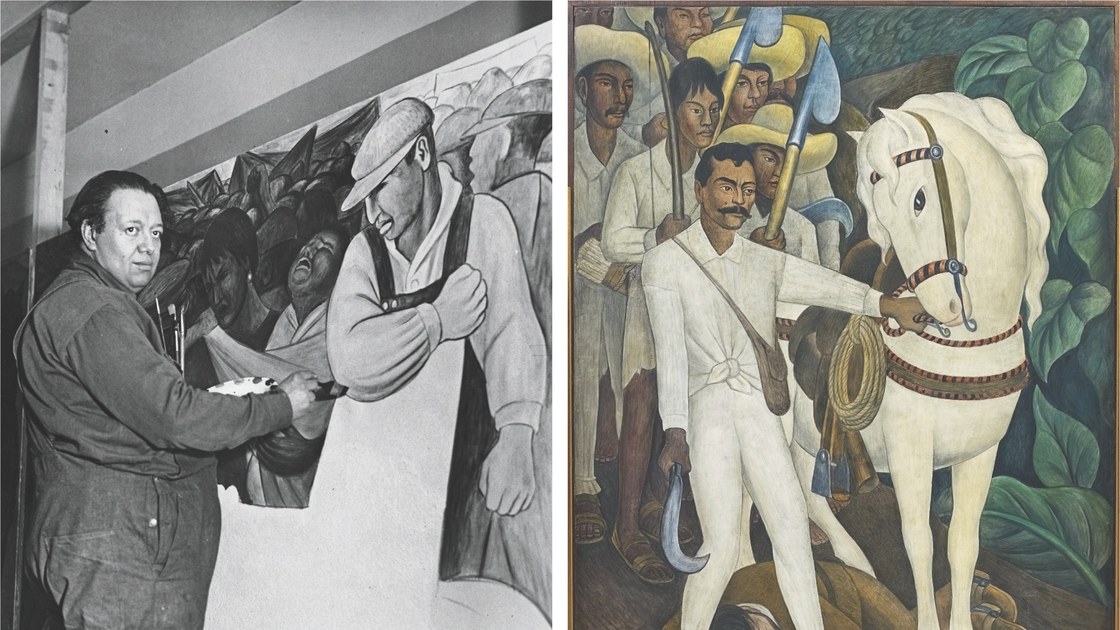
Diego Rivera at work on The Uprising; Agrarian Leader Zapata
The kind of mutuality and affinities which the Revolution sparked in Indian literature and Asia can also be traced in African and South American art and culture, too, notably in the the work of Diego Rivera.
Up until the Revolution, the global dissemination of art and culture had always had an imperialistic dimension. It was inextricably entwined with the capitalist exploitative colonial project, a means of imposing metropolitan cultural values on other peoples. After 1917, just as the Revolution strengthened radical political opposition across the world, so it enabled indigenous cultural and artistic traditions to flower and make international connections, on a scale not seen before in human history.
Closer to home, an example of this international effect was the leftist poetry movement in 1930s Britain led by Auden, Macneice, Spender and others. They were inspired by the Revolution to create a more overtly political, even didactic literature. In both form and content they aimed to connect more closely with the mass of the population. And there’s no doubt of the huge influence of the Revolution on many other writers like George Bernard Shaw, H.G. Wells and Virginia Woolf.


George Bernard Shaw; W.H.Auden and Benjamin Britten
This literary movement itself influenced musicians and composers like Alan Bush and Auden’s friend Benjamin Britten, who was also independently attracted to communist and specifically Russian culture.
It spread also to documentary film-makers like the GPO Film Unit and its successors, who started a fine tradition of compassionate and sometimes overtly socialist documentaries on the living conditions of the British people, before, during and after the Second World War.

It is a tradition which was continued by the ‘kitchen-sink’ dramas of the fifties theatre, in TV dramas such as the Wednesday Play and Play for Today, and the exemplary work of Ken Loach right up to the present day.
The wider world was if anything even more influenced by the Revolution than Britain. In literature, art, and music the list is virtually endless. It is striking how left wing political perspectives are so common across all the arts in the twentieth century, and this is partly due to the influence of the Revolution on global culture.


Eisenstein's Battleship Potemkin; Poster for Vertov's Kino-Glaz produced by Alexander Rodchenko
In cinema, the innovative techniques of Sergei Eisenstein, using ‘oppositional’ montage to create a new cinematic language, and Dziga Vertov, capturing ‘film truth’ in a radically new type of documentary, laid the foundations of world cinema - see John Green's comprehensive and authoritative survey of Soviet cinema. It is widely recognised that John Ford, Orson Welles, the Italian neo-realists, Carol Reed, Hitchcock, Coppola, Scorsese, and many others were heavily influenced by these Russian pioneers.
The revolutionary impact on appreciation and enjoyment
Secondly, there is another kind of influence, which is the impact of the Revolution not only on production but on consumption - on ways of accessing, experiencing and enjoying cultural activities.
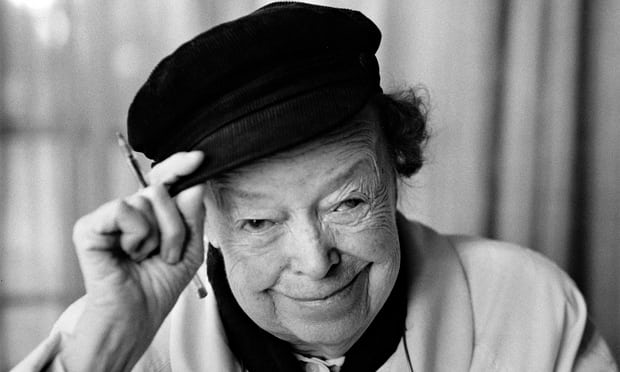

Joan Littlewood; the People's Theatre, Newcastle
For example, there was the establishment of workers’ film societies in Britain, which brought quality cinema closer to working class people. The people’s theatre movement in Britain also grew very strongly in the 1920s, encouraged by G.B. Shaw, a strong sympathiser with the ideals of the Revolution. They were taken forward by Joan Littlewood and Ewan MacColl into both popular theatres and folk music clubs, before and after the Second World War. Joan Littlewood was heavily monitored by MI5: what better evidence can there be of Bolshevik influence?
Radical workers’ theatre in the rest of Europe and the United States was massively stimulated and energised by the democratising, anti-elitist influence of the revolution, and there was also a workers’ radio movement in Europe.
The revolutionary nature of art
The third kind of positive influence of the Revolution on art and culture was deeper and more general. It is an influence shared with every other progressive revolution in history.
Just as one of the main benefits of the Russian Revolution was to strengthen not only specifically radical political and economic alternatives to class-divided societies, but the very possibility of realising an alternative at all, so the Revolution did the same for artistic and cultural activities.
This is because as William Blake and others have recognised, artistic and cultural activities like poetry, art and music are fundamentally social and communal activities. That is why and how they evolved in human history: they are essentially acts of powerful, rousing and empathic communication which develop and deepen human sympathy and solidarity. Art – and other cultural activities such as sport and religion – can overcome and break down all kinds of barriers between humans. Cultural activity can overcome and dissolve, in reality as well as in our imaginations, the fundamental class divisions in human societies based on unequal shares of private property that have existed since ancient times.
The challenge to class-based society which the Revolution represented enabled and empowered artists, writers, musicians and their publics across the world to make, understand and enjoy art which was critical, challenging and oppositional to the status quo.
These countercultural, challenging strands can be traced in all the arts. This was something peculiar to the Russian Revolution, or totally new – evidence of artistic opposition to injustice, inequality and hierarchical oppression can be traced back through human history, as can the insistence of artists on the liberating power of creativity - see Doug Nicholl's article on Lugalbanda. But the Revolution strengthened that liberating, oppositional strand which is always, everywhere present in human cultural activities, the 'counter-hegemonic' forces identified by Antonio Gramsci.

Pablo Picasso, Guernica
Without the Revolution, there might well have been artistic protests against war and imperialist aggression, progressive religious movements, museums and art galleries, and cultural education for more people. But would there have been Guernica? Liberation theology? People’s museums? Comprehensive arts and sports education?
The Revolution enabled a more confident, collectivist and communal challenge to elite forms of art – not only its themes and content, but its mode of production, distribution, accessibility, reception and criticism.
Inspiring art and progressive politics have always been inextricably intertwined, which is one of the reasons why conservatives and liberals always want to keep them separate. The Russian Revolution firmly connected them, and all the debates about art and politics since then have been influenced by it. For example, the very idea of art and other cultural activities needing to respond to the needs of the mass of the population and not just serve ruling elites was given an enormous boost, which has influenced arts and culture policies across the world ever since. Those agit-trains agitated the world!
The revolutionary impact through resistance and reaction
All these positive influences of the Russian Revolution on art and culture have also been resisted, undermined and often beaten back, in ‘cultural wars’ which continue today.
This takes us to a fourth, very mixed legacy of the Revolution in world culture today, which is a consequence of the deep and long-lasting opposition of the capitalist powers to the Russian Revolution.
From the beginning there was diplomatic, economic and military opposition from the United States, Britain and other European powers to the anti-capitalist nature of the 1917 Revolution. This was temporarily replaced by an antifascist alliance in the Second World War, but thereafter quickly degenerated into various open and proxy conflicts across the globe during the Cold War.
This hostility and failure to support the fundamentally democratic advances made in Russia after the overthrow of autocracy caused tremendous suffering in 1920s and 1930s Soviet Union, directly and indirectly. Enforced isolation and the crushing of attempts to spread the radical impulse internationally were tragic, missed opportunities for what could have been an international flowering of human life, materially and culturally. Western elites, through acts of commission and omission, carry a huge responsibility for the sufferings of peoples across the world in the twentieth century.
In the Soviet Union, the defensive reaction to capitalist reaction and aggression led to the submersion and disappearance of some of the positive aspects of revolutionary culture. The pluralism of cultural policy under Lenin and Lunacharsky, and the bold ambition of the Proletkult - see article by Lynn Mally - was eroded into a much narrower approach to the arts and culture generally. Although the early Soviet state was always far more directly supportive of the arts and culture than capitalist democracies – particularly regarding literacy, cultural education and general access for the masses, for example – it also developed heavy-handed censorship arrangements, and intolerance of artistic and musical dissent and nonconformity.
The cultural influence of anti-communist hostility of the West was also expressed within capitalist countries. It took – and takes – many forms. Just to take one country, the United States, for example, there was the blatant, career-threatening persecution and blacklisting of left-leaning screenwriters, actors and directors in the film industry and other creative industries.
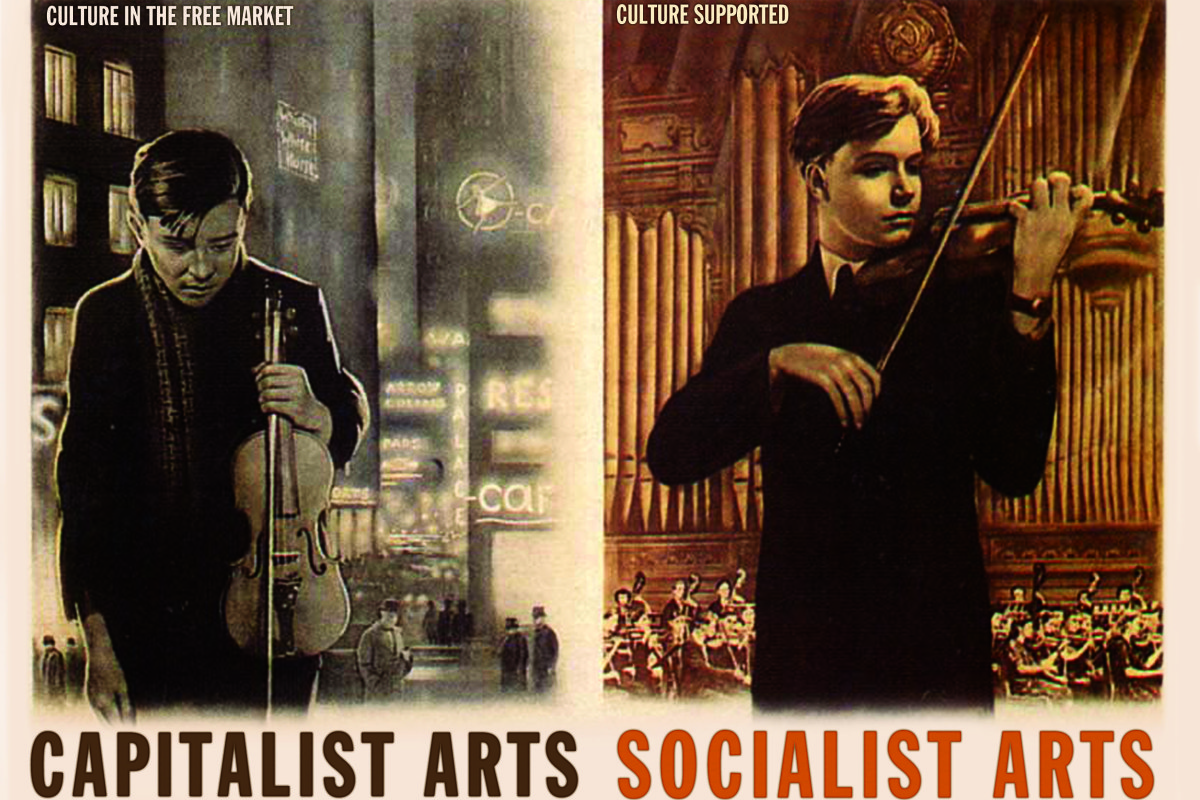
American postcard, 1930s
Another clear example is how the CIA covertly funded certain art forms such as abstract expressionism, and put pressure on various cultural institutions, in order to counter the left-leaning realist traditions in the visual arts (photography as well as painting) which were developing in Thirties America.
It is important to remember that this anti-communism is still current. The elites of Western powers have not forgotten or forgiven the power of artists to advance progressive and revolutionary political agendas. It is evident in the continuing prejudice of the American and British film industries against genres such as social realism and other cinematic attempts to tell the truth about capitalist exploitation and oppression. Individualistic, sexist themes which are congruent with capitalist culture, such as lone brave violent males supported by emotional caring females, dominate our screens. Because films generally are made for quick profit rather than for quality of insight and enlightenment, they rely overwhelmingly on superficial values including melodrama, sentiment, spectacle, glamour and celebrity, over real insight, intellectual depth and social relevance.

Poster, Go to the Stadiums!
Sport provides another instructive example. As Gareth Edwards relates in his piece, the Revolution opened up the possibility of more grassroots-driven, widely-practised and co-operative forms of sport which did not rely solely on the excitement generated by individual competition. The remarkably progressive approach to womens’ rights in the polity and economy was paralleled by advances in the access of women to sport and physical pursuits, for example in the growth of womens’ athletic organisations. This caused a hardening of elite attitudes in the West. It was at least partly responsible, for example, for the crushing of womens’ football by the FA in 1921 and other attempts to maintain the cultural dominance of white men.
The Cold War and the triumph of neoliberal capitalism, with its accompanying culture of competitiveness, elite celebrity and individual excellence, has also tended to corrupt sporting ideals. The Olympics, instead of being a celebration of human sporting ability, was turned into another proxy ideological and nationalistic battle between capitalism and socialism, and has still not fully recovered. Recent and ongoing drugs scandals across swathes of sporting activity bear witness to the insidious pressures of commercialism, individual achievement through winner/loser competitiveness, and celebrity culture.


Great art and poor curating at the RA: Alexander Deineka, In Defence of Petrograd; Malevich, Woman with a Rake
This anti-communism has also manifested itself this year, in various TV programmes and exhibitions. The exhibition of post-revolutionary Russian art at the Royal Academy, for example, was strikingly reactionary. Funded by the Blavatnik Foundation, a beneficiary of the sell-off of state-owned assets when the USSR collapsed in 1989, the exhibition abandoned the usual liberal approach of trying to provide a balanced historical account of the political background and art of the Revolution. Instead, it promoted an openly hostile perspective, which downplayed, denied and derided links between the progressive politics of the Revolution and the marvellously energetic and powerful art that it inspired. In general, mainstream media coverage of the centenary has been predictably hostile, uncomprehending, tepid, or plainly mistaken - exactly the same problems that characterise its coverage of Corbynism, and for exactly the same reasons.
The revolutionary influence today
In complex and deeply interwoven strands across all of human cultural activity in the last hundred years, the Revolution has had a massive effect. Its power and influence can still be detected in debates about the links between politics and economics on the one hand and art, sport and religion on the other. In all these debates, the example of Russia is inescapable.
It has left us with some tremendous and enduring examples of excellence in all forms of artistic and cultural activities, across all the world and across the hundred years since 1917. And because of the resistance of ruling elites, it has also led to a polarisation of debates and of practices.
Ever since 1917, there has been debate about the detailed legacy of the Revolution for art and culture. But one thing we can surely all agree about, at least on the Left, is the way it strengthened the capacity and confidence of art and artists to creatively imagine difference, improvement, and radical alternatives to what is.
This influence is extremely relevant today. We face increasing struggles against the incursions of capitalism into our human culture these days. There are all kinds of different barriers and pressures – financial, geographical, thematic – which tend to twist and corrupt human culture. Naturally healthy and developmental cultural activities such as art, sport, religion, eating and drinking, in all their myriad forms, are facing pressures to become corralled into expensive, inaccessible, privatised and patrolled enclaves for the rich and powerful.

In the current struggles that we face to democratise culture, to make it accessible and relevant and affordable to the mass of working-class people, the example of the Russian Revolution is like a beacon of inspiration. It shows us that things don’t have to be the way they are, that tomorrow may not be the same – and that we can achieve and enjoy a better life.
The team at Culture Matters hope that this piece, and the accompanying articles in this section of Culture Matters, give you some sense of the power and range of global cultural influences which sprang from the Russian Revolution. However, perhaps the most enduring influence of the Revolution lies not just in our appreciation and enjoyment of its tremendous cultural legacy, but in the way it still stimulates and motivates us to act now to fulfil its promise – by replacing the culture, politics and economics of capitalism with a socialist alternative.

